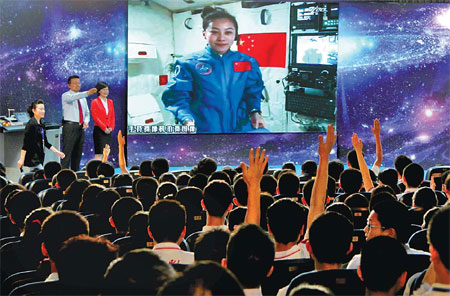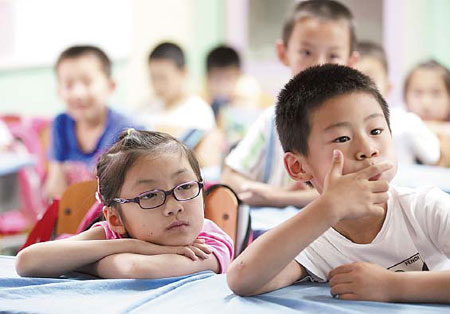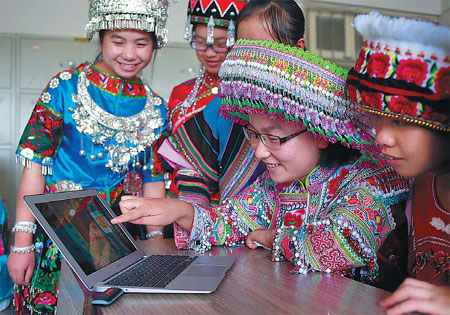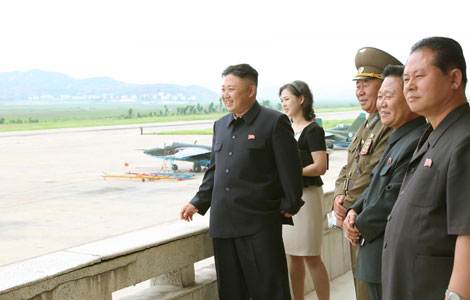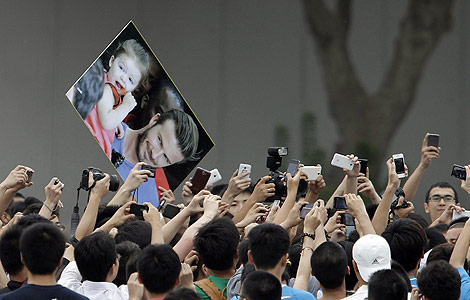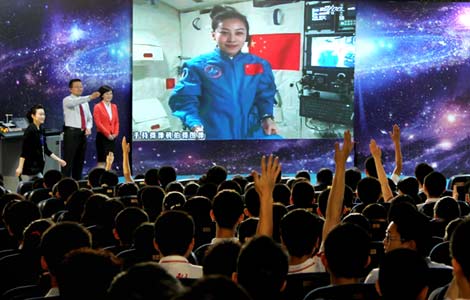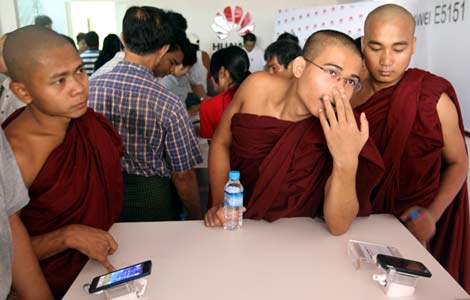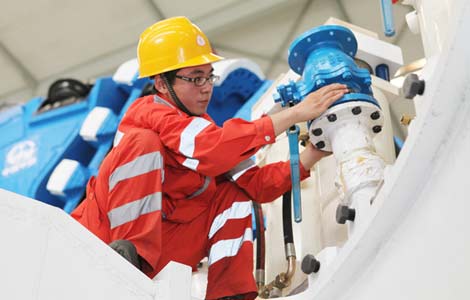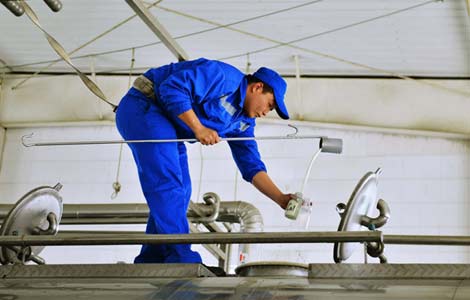A science class from above Earth
Updated: 2013-06-21 07:02
By Xin Dingding in Beijing and Fu Jing in Brussels (China Daily)
|
||||||||
|
Astronaut Wang Yaping teaches a class from space to the High School Affiliated to Renmin University of China in Beijing on Thursday. Gao Haitao / for China Daily |
|
The live lecture attracts the interest of students at a Beijing school. Jin Liwang / Xinhua |
|
Wang Yaping, the second Chinese woman in space, demonstrated how a variety of objects - from a spinning toy to a bubble of water - behave in space. Xinhua |
|
Ethnic Miao students from a middle school in Kunming, Yunnan province, watch astronaut Wang Yaping's lesson from the space. Feng Yongbin / China Daily |
Gravity-free lesson helps young students float fresh ideas
Astronaut Wang Yaping wowed millions of students on Thursday when she held China's first science lesson from space.
Wearing a blue spacesuit and appearing via video link, China's second woman in space demonstrated physics only possible in low gravity.
It was the second video class delivered from an orbit more than 300 kilometers above the Earth's surface, with US astronaut Barbara Morgan's 25-minute class being the first in 2007.
"We hope the class will trigger young people's interest in space and spur their spirit of exploration," said Yu Changxue, a senior official with the Ministry of Education.
The class, with one part held in a Beijing school with 335 student representatives from 16 schools and the other held in the orbiting Tiangong-1 space module, started with a short video recorded by the three astronauts that introduced how they sleep in a standing position in blue sleeping bags, how they eat and drink from sealed bags, and how to somersault in space.
Commander Nie Haisheng made a show of crossing his legs in the air in a meditation posture - which only a martial arts master can do in the movies, but is impossible for people on Earth.
Wang smiled as she pushed Nie into the wall of the module with a gentle nudge of her hand, and went on to gulp down a floating drop of water.
"Thanks to the weightless condition, we're all masters," she joked.
The two then conducted a string of experiments that demonstrated how objects behave in low gravity - from a bubble of water to a spinning toy.
Wang started with a question of how astronauts measure weight in the weightless orbiter.
Nie demonstrated by measuring his weight on the special scale onboard the orbiter, which was designed on the basis of Newton's second law of motion, or measuring the mass of an object through net force and acceleration.
It was followed by an experiment where she held out a small ball tied to a string. "What will happen if I let the ball go?" she asked.
The ball did not swing as it would on Earth but stayed suspended. When she pushed the ball gently, the ball moved in a circular motion, which stirred the classroom a bit.
Wang later pushed a static gyro and a moving gyro to change the way they move.
What appeared to excite students most were the experiments with water.
Wang made a film of water with a metal ring, and then a ball of water to explain how zero gravity magnified surface tension.
Chen Yumeng, 16, a student from Beijing No 80 High School, said the water ball experiment was an eye-opening experience, as it is impossible to see on Earth.
On Earth, the effect of gravity and buoyant force will make air ascend inside water, but in low gravity, air bubbles stay inside the water, she said.
"The demonstration is too short, just 40 minutes," Chen said. "I wished the astronauts could do more experiments up in space."
Xiao Jianqiao, a student from Beijing No 2 High School, said he never imagined the astronauts would demonstrate objects in low gravity in such innovative ways.
"Today it's really a joyful surprise that our Chinese astronauts did things like inject red liquid into a ball of water, making its shape stand out."
After the experiments, astronauts also answered questions from students, including the difference between up and down in space, the recycling of water in the orbiter, space debris, the impact of a gravity-free environment on the human body and the view through windows of Tiangong-1.
"Through the front windows, we can see the Earth and many other stars, but up to now we haven't seen any UFOs," Wang said in answer to a question from a fourth-grade student.
"I will tell you a wonderful phenomenon: We can see the sun rise 16 times a day, as we circle the Earth every 90 minutes," she said.
Karl Bergquist, the administrator for international relations department at the European Space Agency, said events like the space lecture are very important to increase the interest and awareness of young people for space exploration.
"I am sure that there are many of the students in the audience who, today, after the lecture, are dreaming of becoming astronauts or working with space when they grow up."
On Thursday, about 60 million students from 80,000 middle schools watched or listened to the live broadcast on TV and radio.
The video class received warm feedback from students, and experts said preparations started a year ago.
Jin Sheng, a member of an expert panel that planned the experiments, said ideas were solicited from the public.
"In a spacecraft with limited space, where supplies are measured by grams instead of kilograms, the fact the astronauts had brought 2.9 kg of teaching aids shows China has attached great importance to education," he said.
"Listening about things differs greatly from seeing things with your own eyes. After seeing these wonderful phenomena, the children will develop interests in science and think of questions from a different angle. This is the meaning of this class."
The Shenzhou X spacecraft, which lifted off from Jiuquan Satellite Launch Center in Northwest China's Gansu province on June 11, is expected to return on Wednesday after 15 days in space.
After a successful robotic docking last week, the astronauts will conduct a manual docking.
Contact the writers at xindingding@chinadaily.com.cn and fujing@chinadaily.com.cn
(China Daily USA 06/21/2013 page1)
Most Viewed
Editor's Picks
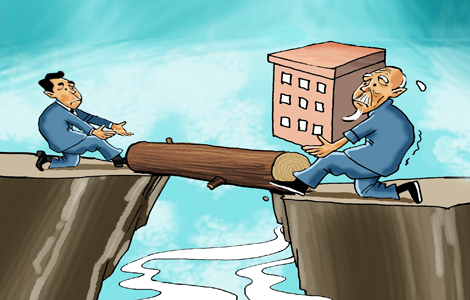
|

|

|

|

|

|
Today's Top News
China slams US human trafficking report
China urges resumption of six-party talks
SEC charges China-based firm with fraud
Bank of China denies monetary default report
Snowden's future hangs in balance
China reiterates support for the UN
Dairy measures start at source
June PMI signals weakness
US Weekly

|

|
